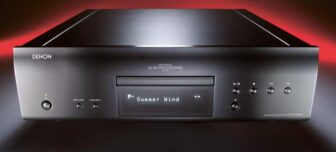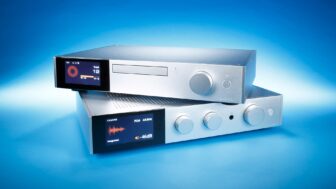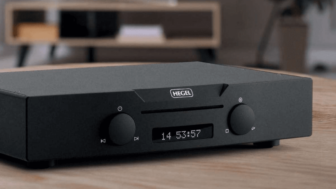Accustic Arts Player III Review
A manufactory from Lauffen keeps the CD alive. With the Player III, Accustic Arts (sic!) presents the successor to the Player I. This test reveals what’s up with Player II and how to solve the riddles around its name and operation.
Most people back then got it wrong when predicting how long vinyl would remain once the Compact Disc was introduced. While vinyl, not least thanks to the club scene that many older audiophiles often criticized, got an extended lifespan with no expiration date, the CD almost completely disappeared from the market. Yet many, like me, still have large CD collections they can’t part with—not to mention colleague Brandt, whose collection fills an entire basement. As old white men, we naturally depend on the continued existence of decent playback devices. A particularly elaborate and high-quality specimen comes from Lauffen am Neckar.
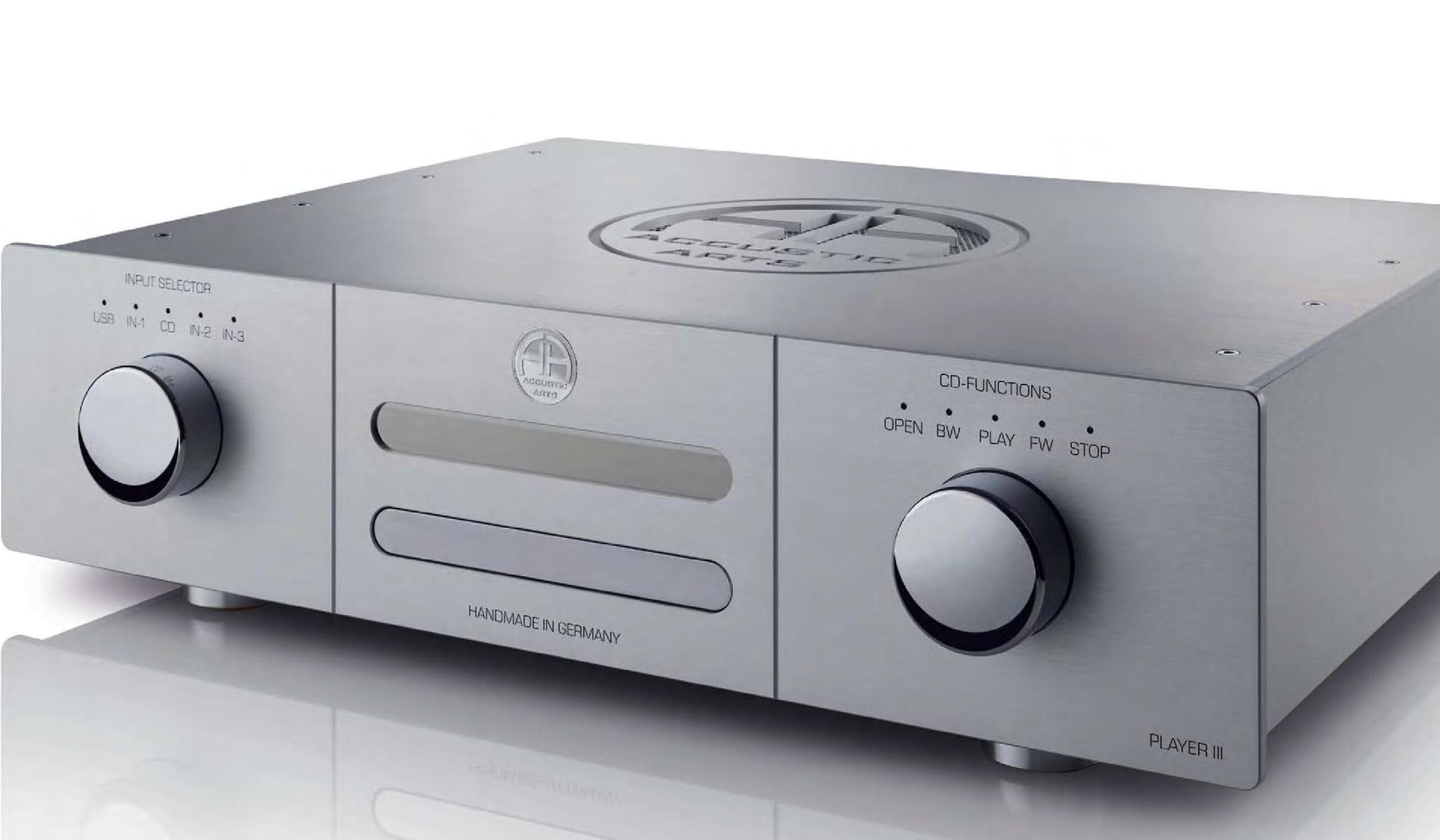
In the Accustic Arts manufactory, CD players, integrated amplifiers, and pre/power amplifier combinations are handcrafted with a certain glamour factor. The brand not only showcases an independent design, but the logo integrated into the massive XXL-format aluminum top cover of the Player III also features cutouts that double as cooling vents. A red glow inside lights the logo up in Hollywood fashion.
The model name, Player III, suggests there are two predecessors. But newcomers might be surprised by the brand’s individual logic, which is not only spelled differently than phonetically expected. Accustic Arts is just an abbreviation and actually stands for ACCUrate acouSTIC ARTS. Got it? In line with this quirky logic, the Player III is not the successor to the Player II but rather to the Player I. That’s because CD player number II belongs to the Reference Series, while Player I and Player III belong to the Top Series, which is one tier below.

A major enhancement stands out when comparing both generations: the CD player, which also doubles as a high-res converter, now accepts DSD 512 over its USB-B port for PCs and Macs instead of DSD 256. With PCM signals, the maximum resolution remains unchanged at 32-bit/384 kHz. The Player III also shines with a chrome-plated emblem on the front instead of an engraved brand logo.
As mentioned, this CD player—featuring a smoothly running tray made of an aluminum-ABS compound—can also be used as a high-resolution D/A converter. In addition to the asynchronous USB 2.0 input, three more digital inputs are available: two coaxial and one optical. Other highlights include two encapsulated 25 VA toroidal transformers from Talema Elektronik in Germering. One of them powers the spatially separated converter section, which promises advantages due to lower interference in the sensitive audio signals.
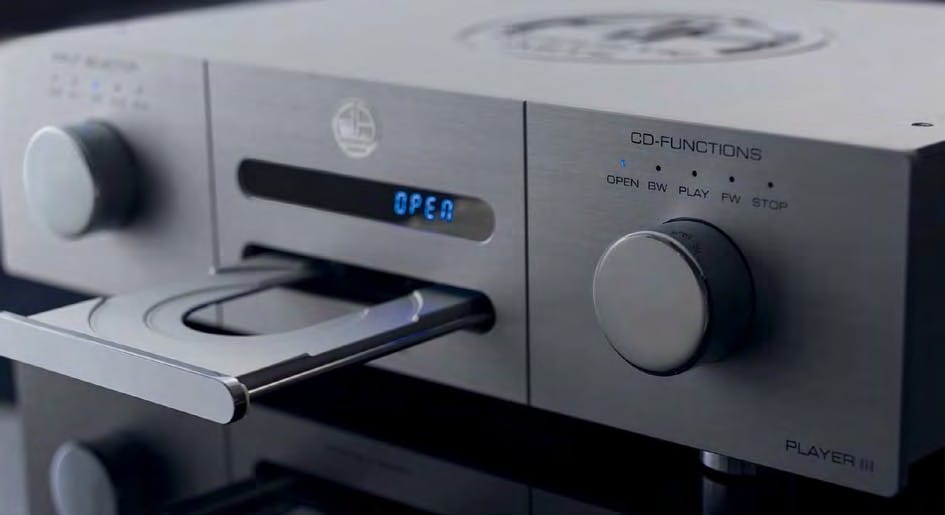
From my perspective, the very unconventional operating concept was somewhat annoying or time-consuming during the listening test. Even though the power switch at the back was turned on and a blue LED on the front panel was lit, the Player III refused to start operating. There was no standby button on the supplied system remote. Not on the device either. For a veteran used to achieving results without glancing at the manual, this was a real challenge. After some head-scratching and unprintable expletives, I pressed the left rotary knob, which selects the source, on a hunch—and the CD player sprang to life.
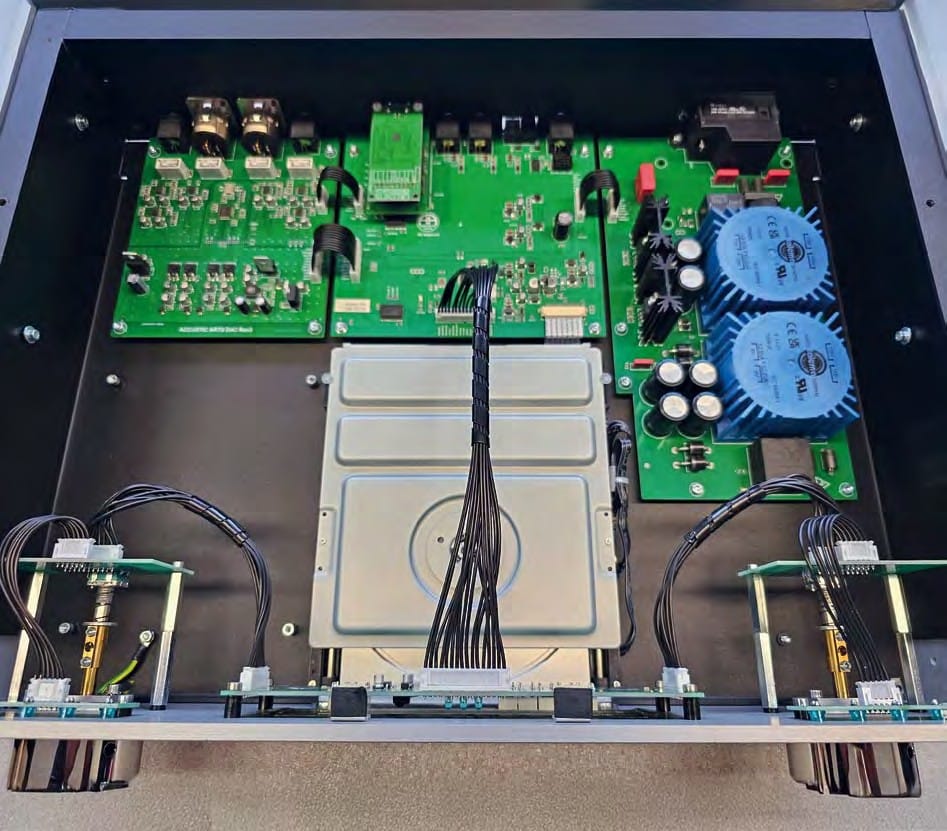
You could hardly say that the Player III started the listening test with a bonus, especially since the rotary/push control for playback introduces unnecessary complication. But its sound made all the head-shaking vanish in no time. After the Player III brilliantly played back my library of magazine cover CDs, I heard the benefits of CD in exquisite sound quality. I put on a CD I had bought at a concert in a jazz club a few days earlier. It supports the band and gives me another chance to relive the concert. The brilliantly balanced tonality, free of any technical aftertaste, gave Alma Naidu’s voice a natural warmth. The resolution of the hi-hats, the three-dimensional imaging with plenty of space between the sound sources, and the dry punch of the bass drum transported me right back to the Bix club in Stuttgart.
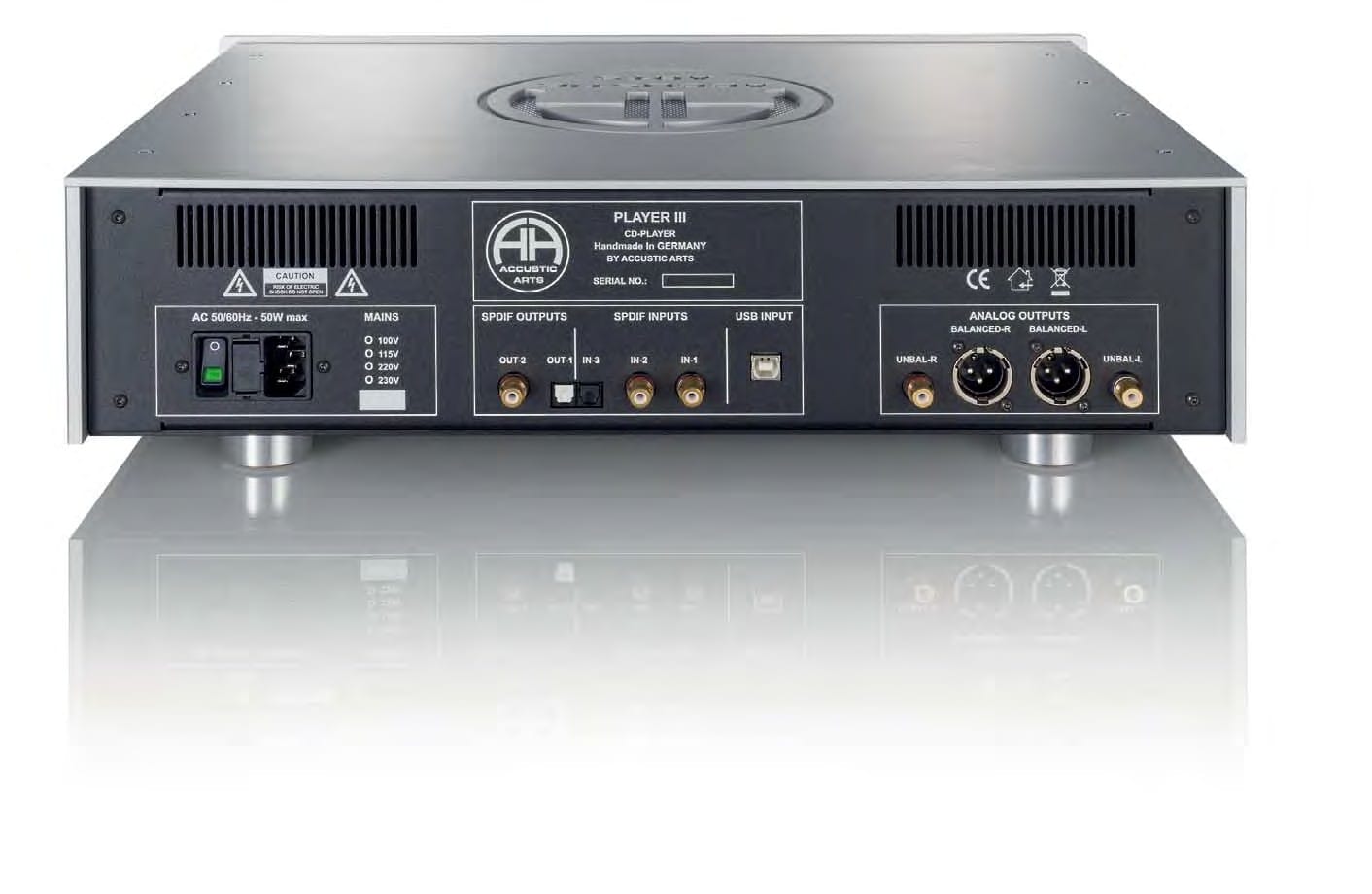
TECHNICAL SPECS
| List Price | 12,000 Euro |
| Warranty | 3 Years |
| Dimensions (W × H × D) | 48.2 × 13 × 38 cm |
| Weight | 13 kg |
Features
- Random Track Selection: Yes
- Playback Time (Track / CD / Program): Yes / Yes / Yes
- Remaining Time (Track / CD / Program): No / No / No
- Repeat (CD / Track / A–B): Yes / Yes / No
- Remote Control: Yes
- Output Variable / Fixed: No / Yes
- Outputs Cinch / XLR: Yes / Yes
- Digital Output Cinch / Optical: Yes / Yes
- Headphone Output / Variable: No / No
- Digital Input Cinch / Optical / USB: Yes / Yes / Yes
- USB Host / iPod: No / No
- Special Feature: Usable as DAC
Accustic Arts Player III Performance Measured
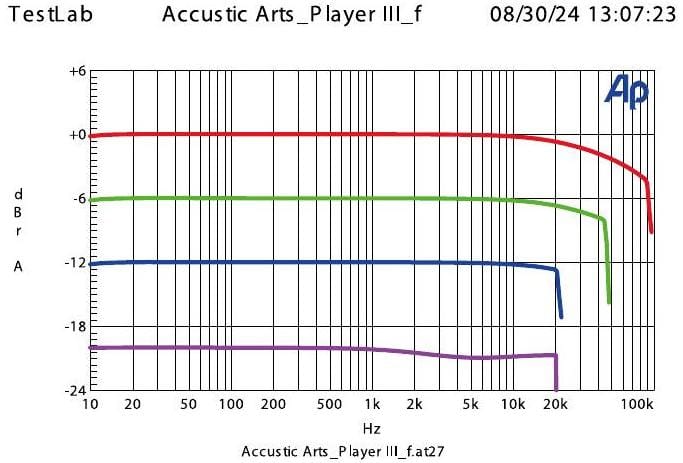
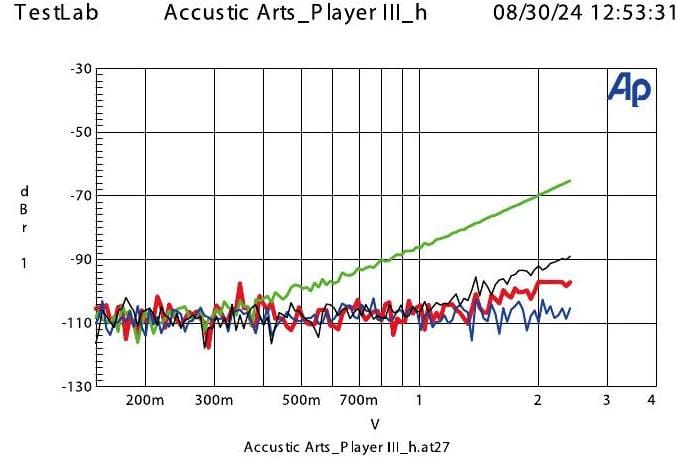
The frequency responses with PCM digital audio (192/96/44.1 kHz) softly roll off above 20 kHz, depending on the sampling rate. The mostly linear purple curve shows that there is a decoder for pre-emphasis encoded CDs; if it were missing, the frequency response would rise around 10 kHz in the highs. Harmonic distortion: third-order remains (green) increase with output voltage.
The total distortion-plus-noise figure is 0.016%. Output voltage RCA/XLR 2.4/4.8 V (fixed, no volume control). Output impedance RCA/XLR 10/20 Ω. Signal-to-noise ratio (weighted) 96/24 RCA/XLR 101/112 kHz; CD playback 99 kHz (silence), 94 kHz with the quietest possible signal, the value applies to both RCA and XLR. Power consumption standby 0.7 W; operating 13 W.
Verdict
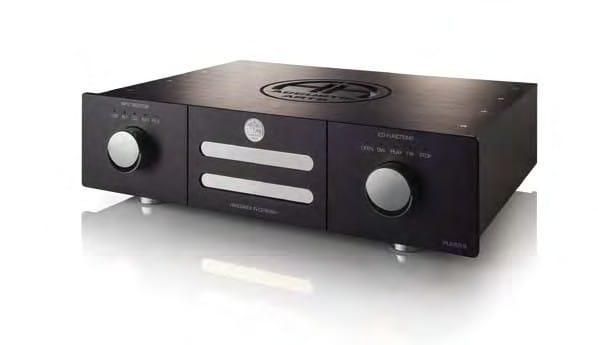
The operation is a matter of taste. There are no two opinions about sound and build quality. The Player III is a game-changer for audiophiles who want to maintain optimal access to their CD collection.
Test Results
- Sound (Cinch / XLR): 187/188
- Features: Very good
- Operation: Good
- Build Quality: Outstanding
AUDIO BENCHMARK
- Overall Rating: 188 Points ≈ 9.4 out of 10
- Price/Performance: “highendig” (high-end category)
Accustic Arts Player III & Power III Phono – High End-Duo im Edel-Look – vorgestellt
Nächstes Level, neuer Look: Accustic Arts bietet seinen frischen CD-Spieler/DAC Player III (Unser vollständiger Test hier: ...



